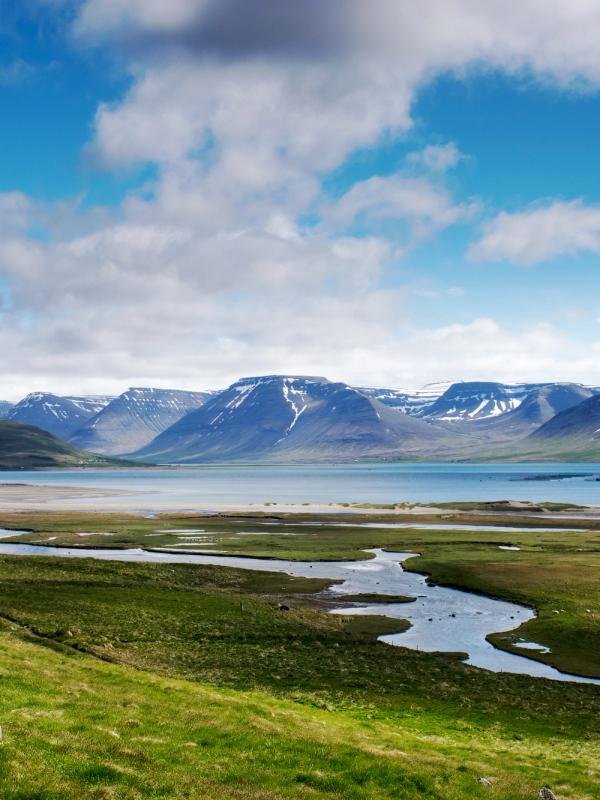
Þingeyri, a great stop in the Westfjords
Road-tripping is, without a doubt, one of the best ways to discover Iceland. There’s so much to see and discover in this beautiful Nordic country that you’ll want to sleep between stops to make the most of your trip. One of the most unique regions in Iceland is the Westfjords, the northwestern corner of the island. It’s a remote and isolated area, but it’s full of magnificent things to see.
And there, there are a few towns that complete the natural beauty to perfection. One of them is Þingeyri, a village known for its quiet charm and untamed beauty. Located on the shore of one of the region’s most picturesque fjords, it’s a great stop in this lesser-explored corner of Iceland. If you’re looking for a great place to park your campervan, you’ve got to go to Þingeyri.
Key Takeaways
- Þingeyri is a small town located on the shore of Dýrafjörður, a beautiful fjord.
- It’s in the Westfjords, one of the eight regions that make up Iceland.
- There’s a campsite in the town, with space for campervans.
What’s Þingeyri?
Þingeyri is a nice fishing village on the shore of Dýrafjörður, one of the Westfjords’ most picturesque fjords. It has a small population of about 300 residents but is big in charm. It’s a peaceful spot where the rhythm of life goes along with nature. The town is located on a flat and narrow stretch of land between a mountain and the dark waters of the fjord, creating a dramatic backdrop that changes with the light: golden in the summer, a snow blanket in winter.
Historically, Þingeyri was one of the earliest trading posts in this region, dating back to the 17th century. This past busier time can still be felt in the old warehouses and Þingeyrarkirkja, a striking church built in 1912.
For campervan explorers, Þingeyri is more than a pretty view; It's a great base to explore the area. The surrounding landscapes are packed with great attractions. One can go hiking in one of the many mountain trails, kayaking in the calm waters of the fjord, or simply enjoying the peace and quiet. Photographers will find endless inspiration in the interplay of light and shadow on the cliffs. And if you’re into history, you can connect with the Viking era at the nearby Þingeyrar, an ancient assembly site.
This village is far from the busier scenic routes and tourist hotspots of Iceland. Þingeyri offers a raw, authentic slice of Iceland.
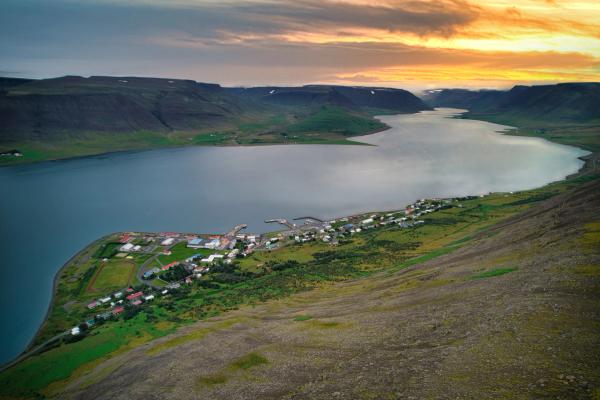
Where’s Þingeyri and How to Get There?
As we have already said, the Westfjords is one of the most remote and isolated regions in Iceland. Þingeyri is about 380 kilometers (236 miles) northwest of Reykjavík, Iceland’s capital. Driving there in a campervan is an adventure in itself, going through the country’s varied and wild landscapes.
From Reykjavík, head north on Route 1, the famous Ring Road, for roughly 100 kilometers (62 miles) until you reach the city of Bifröst. Turn left onto Route 60 after passing the town. This road goes along the fjords and into the heart of the region. Continue on it for another 250 kilometers (155 miles) until you see the crossroad with Route 622. There’s a sign that says Þingeyri.
The journey takes around 5 to 5.5 hours without stops, but I recommend adding an extra day to your itinerary to make the journey lighter. Once in Þingeyri, parking is quite easy. The village has a small, free parking area near the harbor, perfect for campervans, with a short walk to the center. No need to hike far—everything from the local café to the fjord’s edge is within a few minutes.
The roads leading to Þingeyri are mostly paved, though some stretches may turn to gravel, so a sturdy campervan is ideal. The only possible setback in a trip to this part of the country can happen in winter. The weather in this region is harsh in the colder months, which can lead to road closures. Check the road conditions, also in summer, to make sure your trip can be done without any problems.
Where to Stay in Þingeyri and Nearby
One of the best parts of traveling in a campervan around Iceland is that the country has a lot of stunning places where you can park and spend the night, and Þingeyri’s surroundings offer plenty of camping options. Here are six spots, each with its own charm and facilities.
Þingeyraroddi Camping Ground
Distance: In Þingeyri
Price: 1900 ISK ($14 or €13) for adults (above 16)
This site sits right by the fjord, offering grass pitches, toilets, showers, and a small kitchen area. Electricity hookups are available, and the views of Dýrafjörður are unbeatable. It’s a short walk to the village’s center, so you can easily go to a café or shop.
Korpudalur
Distance: 34 kilometers (21 miles) north of Þingeyri
Price: Adults 2400 ISK ($18 or €17)
Located in a quiet valley near an old hostel, this spot has basic amenities like toilets and running cold and hot water. It’s quieter than Þingeyri’s main site, and there are several trails to explore the area. No electricity, so bring a charged battery. If you want a bit more comfort, you can book a spot in the hostel.
Flateyri Camping Ground
Distance: 40 kilometers (25 miles) north of Þingeyri
Flateyri is another nice little town on the shore of another fjord a bit further north from Þingeyri. The camping ground is a short walk away from the village’s center, and it offers toilets, showers, and a cooking area. It’s near the shore, with mountain views and a small shop nearby for supplies. Electricity is available for a fee.
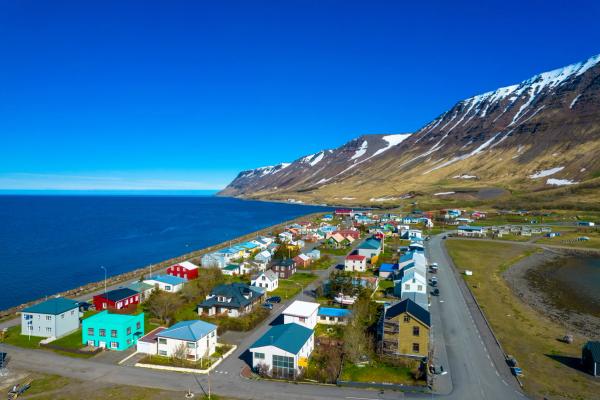
Tungúskógur
Distance: 47 kilometers (29 miles) northeast of Þingeyri
Price: Adults (above 15) 2.450 ISK ($18.50 or €17)
This camping area is outside Ísafjörður, the main city in the Westfjords. It’s in a beautiful location, really close to Bunárfoss, a charming waterfall. It’s one of the most complete camping sites in the region, with toilets, showers, electricity, kitchen, washing machine and dryer, and a playground for children. There’s even wi-fi.
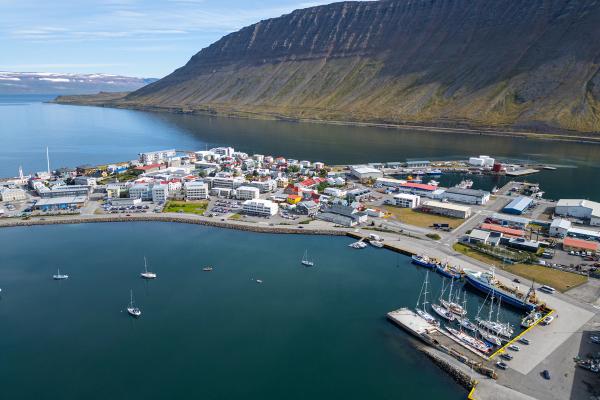
Súðavík Camping Ground
Distance: 62 kilometers (38 miles) northeast of Þingeyri
Price: Adults (above 12) 1500 ISK ($11 or €10.50)
In the village of Súðavík, this site provides toilets, showers, and electricity hookups. It’s close to the fjord and the Arctic Fox Centre, adding a unique twist to your stay. The terrain is flat, making it easy to park.
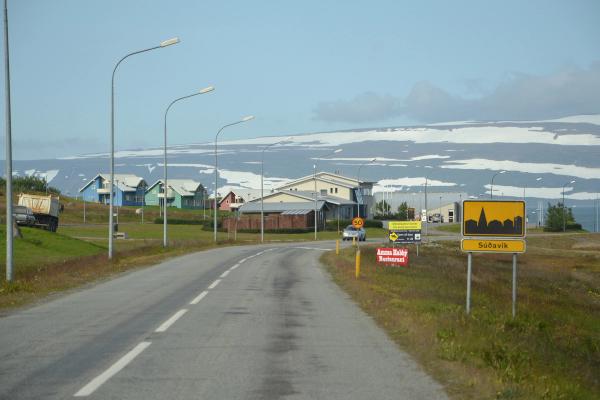
Bildúdalur Camping Ground
Distance: 70 kilometers (43 miles) south of Þingeyri
Price: Adults 1775 ISK ($13 or €12)
This campground in Bildúdalur offers toilets, showers, and a kitchen, with optional electricity. It’s near the town’s harbor, so shops and cafés are nearby. The town hosts the Sea Monster Museum, which is a bonus for curious travelers.
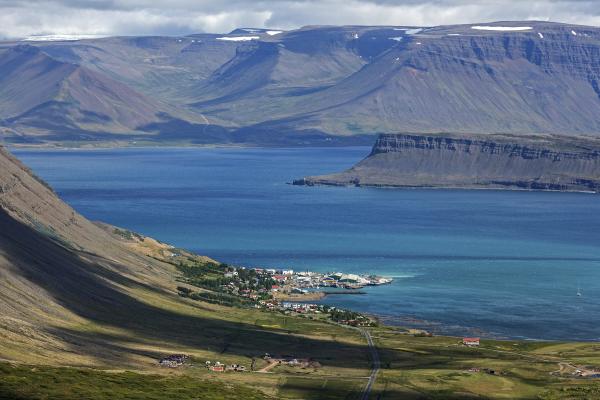
The Weather at Þingeyri
The weather in the Westfjords can be pretty unpredictable, and it changes a lot from season to season. Read on to know what to expect if you visit Þingeyri.
Spring (April and May)
Spring in Þingeyri is cool and unpredictable, with temperatures ranging from 0°C to 7°C (32°F to 45°F). There’s still snow lingering from winter, but the fields start to come alive again. There are high chances of rain, mixed with spells of sunshine. The days lengthen by the week, giving time to explore the outdoors.
Summer (June to August)
The warmest season sees highs of 10°C to 15°C (50°F to 59°F). It’s, in terms of climate, the best season to go to the Westfjords, but also the busiest. The daylight hours are really long; the sun barely sets in late June, which is perfect for campervan trips. Although the weather is mild and stable, there are always chances of rain.
Autumn (September and October)
Temperatures drop to 2°C to 8°C (36°F to 46°F), and the fields in the Westfjords get a golden color. Wind picks up, and rain becomes more persistent. The days are shorter, but there’s still time for adventures.
Winter (November to March)
This season is a time of contrasts. On one hand, it’s really beautiful, with everything covered in snow, but traveling can become difficult. It’s important to check the road conditions because some of them may be impassable. The days are quite short, but there are chances to see the Northern Lights.
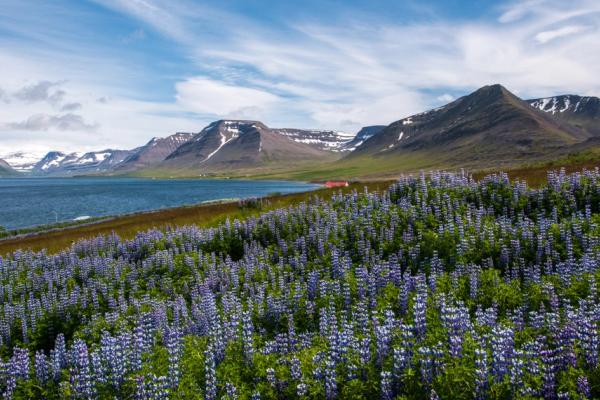
What to Wear at Þingeyri
Knowing what to wear is very important if you want to visit the region comfortably and without surprises.
- Waterproof Jacket: Rain is a constant companion in the Westfjords—keep yourself dry with a good raincoat.
- Layers: The weather changes a lot, and temperatures fluctuate, so the best way to adapt to these changes is dressing in layers.
- Waterproof Pants: They can be a great ally if a storm rolls in in the middle of a hike.
- Sturdy Hiking Boots: The terrain can be rocky and damp—good grip and ankle support are a must.
- Hat and Gloves: The wind can be quite chilly, especially in autumn and winter.
- Sunglasses: Summer’s bright days and snow glare in winter make these surprisingly useful.
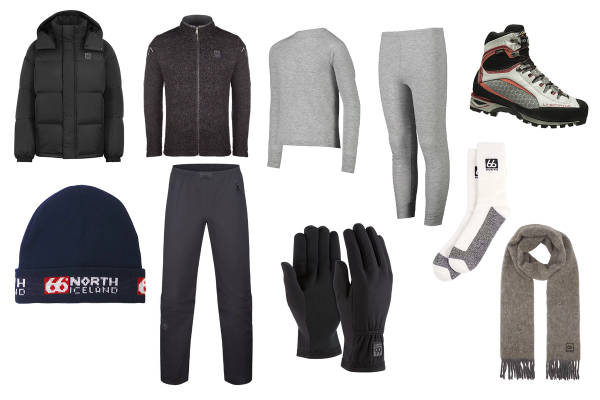
What to See and Do Near Þingeyri
The Westfjords might be remote, but they hide some amazing natural monuments.
Sandafell Mountain
A 367-meter (1,204-foot) peak just outside Þingeyri, Sandafell offers a moderate hike with panoramic views of the Dýrafjörður fjord. The trail is steep but manageable, and the summit rewards you with a sweeping vista of the surrounding landscape.
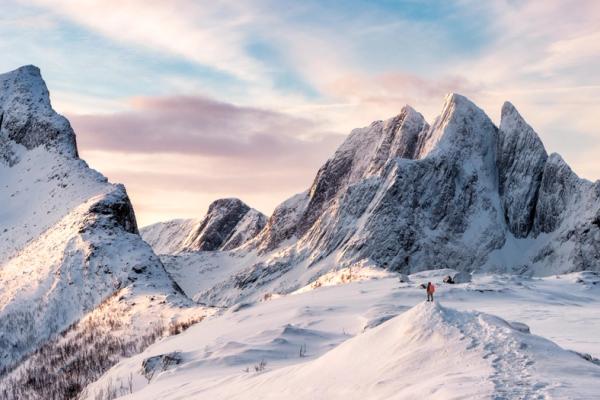
Dynjandi Waterfall
The most famous waterfall in the Westfjords and one of the most iconic of all Iceland. Dynjandi is located 50 kilometers (31 miles) southeast of Þingeyri, and it’s a series of cascades that look like a bridal veil from a distance.
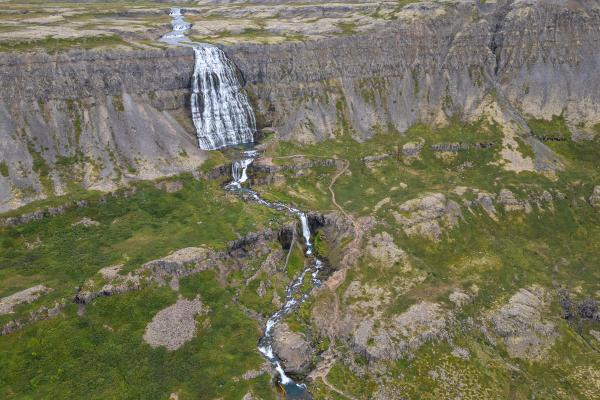
Ísafjörður
The main town in the Westfjords blends small-town charm with rustic beauty. Stroll its harbor, visit the maritime museum, or grab a coffee. It’s a great spot to restock supplies for your campervan. It’s also the gateway to Hornstrandir Nature Reserve, one of the wildest areas in the country.
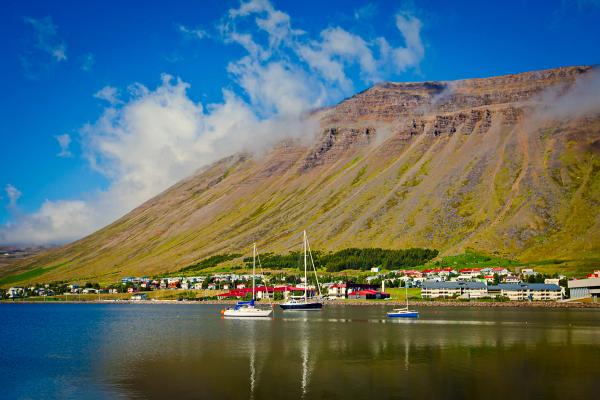
Skruður
This place is a botanical garden, a nice surprise in the area located just on the other side of the fjord. This garden, opened in 1909 and reopened in 1996, is an example of how to grow specific plants and trees under challenging climates.
Kaldbakur Mountain
At 998 meters (3,274 feet), this is the Westfjords’ highest peak, 30 kilometers (19 miles) from Þingeyri. It’s possible to go all the way up, but is recommended only for experienced hikers.
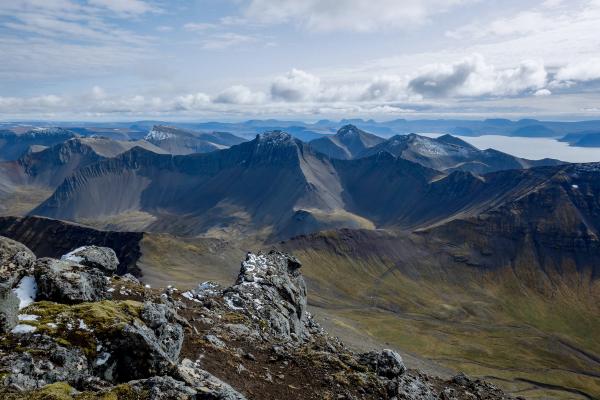
Travel Tips
- Check Road Conditions: As we mentioned before, the roads in the Westfjords depend a lot on the weather, especially in winter.
- Fuel Up: There are not many gas stations in the region, so it’s better to fuel up in main towns, such as Ísafjörður or Hólmavík, before heading to Þingeyri. It's also a good idea to locate the gas stations in your route to plan accordingly.
- Pack Food: Þingeyri has a small shop, but get all the basics in larger towns for flexibility.
- Respect Nature: Stick to marked paths and take all trash with you to preserve the pristine landscape.
- Adapt to the weather: Always have rain gear and warm layers, no matter the season—Iceland’s climate shifts fast. Also, have back up plans just in case.
- Bring a Map: Cell signal can be spotty in the Westfjords—a physical map or offline GPS can be a lifesaver.
Conclusion
The Westfjords are a fascinating region that shows the wildest and rawest side of Iceland. It’s remote, but it’s a fantastic place for a campervan trip. With your home on wheels, you can go explore the fjords, hike in some unparalleled landscapes, or discover the local culture. Come discover this untouched corner of Iceland.
